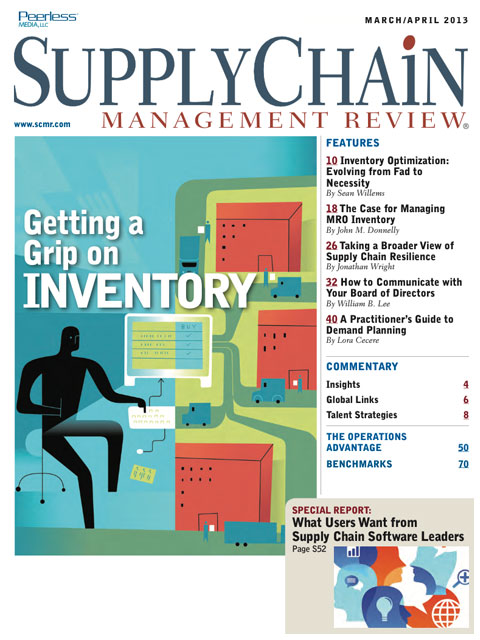Sorry, but your login has failed. Please recheck your login information and resubmit. If your subscription has expired, renew here.
March-April 2013
Inventory needs to be “optimized” to properly match supply and demand. This has become all the more important as competition intensifies globally and supply chains get longer and longer. Learn from a subject matter expert about the benefits of inventory optimization and how to get an IO initiative on track in your organization Browse this issue archive.Need Help? Contact customer service 847-559-7581 More options
How you think about inventory says a lot about where you sit in your organization. Sales views inventory as an opportunity because you can sell what you have. Finance views inventory as a liability, or a depreciating asset; the arrival of these units could have been delayed without harm. Supply chain views it as a buffer reconciling the variability of demand and supply. The perception from the executive team lies on a spectrum ranging from unnecessary waste to necessary evil. Regardless of how an individual views inventory, everyone can agree that inventory should be optimized to properly match supply and demand.
The concept of inventory optimization is not new. The six-volume Library of Factory Management, originally published by A. W. Shaw in 1915, has a chapter on economic order quantity. And for more than a decade, enterprise-class software solutions have helped companies cut billions of dollars in inventory levels. Yet even with nearly 100 years of history, inventory optimization is still perceived by some as more “nice to have” than “need to have.” Further, it is still discussed primarily within the supply chain organization vs. the senior executive ranks.
This article articulates how to move inventory optimization beyond a fad to an integral facet of supply chain planning. To facilitate this transition and make the discussion relevant to senior executives, successful inventory optimization requires the following three active ingredients:
- Change how inventory is measured and discussed.
- Recognize the role of inventory optimization at every level of supply chain planning.
- Choose the right inventory improvement initiatives for your company.
 |
This complete article is available to subscribers
only. Click on Log In Now at the top of this article for full access. Or, Start your PLUS+ subscription for instant access. |
Not ready to subscribe, but need this article?
Buy the complete article now. Only $20.00. Instant PDF Download.
Access the complete issue of Supply Chain Management Review magazine featuring
this article including every word, chart and table exactly as it appeared in the magazine.
SC
MR
Sorry, but your login has failed. Please recheck your login information and resubmit. If your subscription has expired, renew here.
March-April 2013
Inventory needs to be “optimized” to properly match supply and demand. This has become all the more important as competition intensifies globally and supply chains get longer and longer. Learn from a subject… Browse this issue archive. Access your online digital edition. Download a PDF file of the March-April 2013 issue.
 |
Download Article PDF |
How you think about inventory says a lot about where you sit in your organization. Sales views inventory as an opportunity because you can sell what you have. Finance views inventory as a liability, or a depreciating asset; the arrival of these units could have been delayed without harm. Supply chain views it as a buffer reconciling the variability of demand and supply. The perception from the executive team lies on a spectrum ranging from unnecessary waste to necessary evil. Regardless of how an individual views inventory, everyone can agree that inventory should be optimized to properly match supply and demand.
The concept of inventory optimization is not new. The six-volume Library of Factory Management, originally published by A. W. Shaw in 1915, has a chapter on economic order quantity. And for more than a decade, enterprise-class software solutions have helped companies cut billions of dollars in inventory levels. Yet even with nearly 100 years of history, inventory optimization is still perceived by some as more “nice to have” than “need to have.” Further, it is still discussed primarily within the supply chain organization vs. the senior executive ranks.
This article articulates how to move inventory optimization beyond a fad to an integral facet of supply chain planning. To facilitate this transition and make the discussion relevant to senior executives, successful inventory optimization requires the following three active ingredients:
- Change how inventory is measured and discussed.
- Recognize the role of inventory optimization at every level of supply chain planning.
- Choose the right inventory improvement initiatives for your company.
 |
SUBSCRIBERS: Click here to download PDF of the full article. |
SC
MR

Latest Supply Chain News
- Retail sales see gains in October, reports Commerce and NRF
- Balancing green and speed: Home delivery insights from the pandemic era
- AdventHealth named top healthcare supply chain by Gartner
- Geopolitical readiness in supply chains: Strategic challenges for leaders
- Unlocking retention: The role employee engagement plays
- More News
Latest Podcast

 Explore
Explore
Latest Supply Chain News
- Retail sales see gains in October, reports Commerce and NRF
- Balancing green and speed: Home delivery insights from the pandemic era
- AdventHealth named top healthcare supply chain by Gartner
- Geopolitical readiness in supply chains: Strategic challenges for leaders
- Unlocking retention: The role employee engagement plays
- Can supply chain managers embrace an entrepreneurial mindset?
- More latest news
Latest Resources

Subscribe

Supply Chain Management Review delivers the best industry content.

Editors’ Picks





